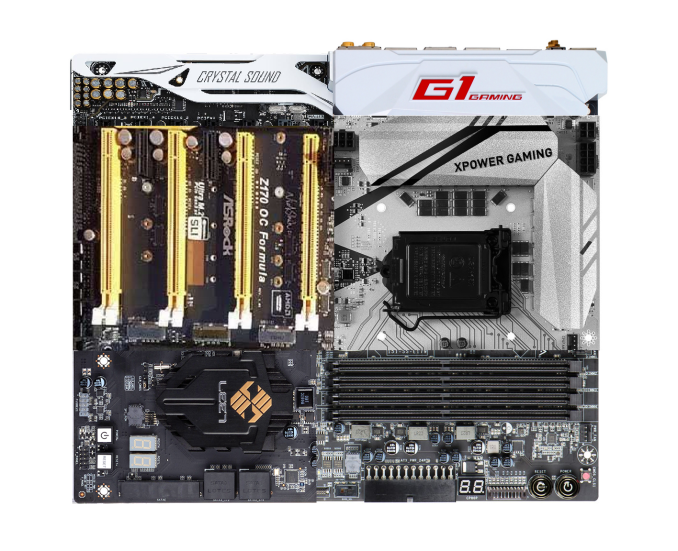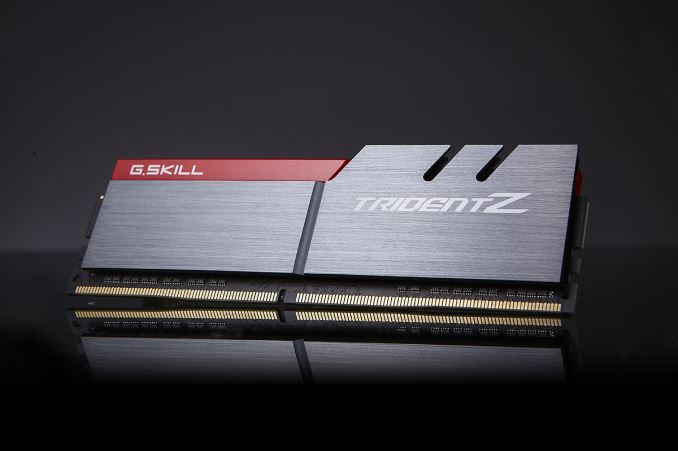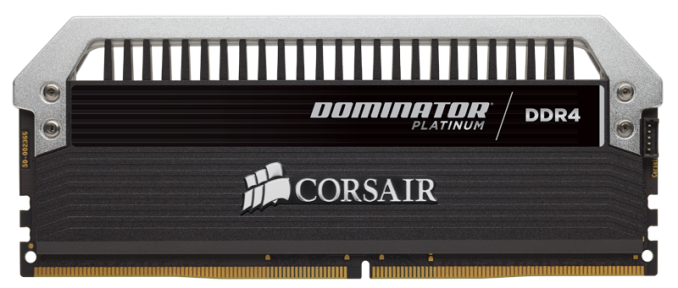The Intel 6th Gen Skylake Review: Core i7-6700K and i5-6600K Tested
by Ian Cutress on August 5, 2015 8:00 AM ESTAlso Launching Today: Z170 Motherboards, Dual Channel DDR4 Kits
The new Skylake processors are assigned a new socket – LGA1151. Intel’s policy since 2006 has been to maintain sockets for two generations and as a result moving from Broadwell to Skylake we were expecting the change. This means that Skylake processors will not work in LGA1150 based motherboards, i.e. those with Intel’s 8th and 9th generation chipsets. For Skylake we get the 100-series chipsets with additional functionality. Launching today in turn is the first member of the 100-series family, the overclocking-friendly Z170, with the other chipsets in the family to follow later in the year.
We have a large piece on the motherboards being released or talked about for Skylake, covering some 55+ products and the different variations within. The major motherboard manufacturers such as ASUS, GIGABYTE, ASRock, MSI, EVGA and a couple of others should all have a wide range ready to purchase on day one, although some models may be region specific.

The badly MSPaint’ed hybrid: MSI’s XPower Gaming Socket, GIGABYTE’s G1 Gaming IO panel, EVGA’s DRAM slots, ECS’s chipset, ASRock’s PCIe arrangement and ASUS’ Deluxe audio.
Here’s an amalgamation of some of the designs coming to end users, with almost all of them investing heavily in gaming brands with specific components to aid the user experience while gaming. Aesthetic designs are also going to be a focus of this generation, with some of the manufacturers moving into a different direction with their designs and trying some new color schemes. Some basic looking models will also be available.
Prices for Z170 motherboards will range from $80 all the way past $400+, depending on feature set and size. A number of motherboards above $150 will feature a couple USB 3.1 Gen 2 (10Gbps) ports, although you will have to check whether they are Type-A or Type-C. That being said, most motherboards with USB 3.1 will use both, but there are a select few that are C-only or A-only. Also over $150 we will see a lot of Intel’s new network controller, the I219-V, although the gaming lines might invest in Rivet Network’s Killer solution instead.
Intel is launching the Alpine Ridge controller at this time as well, which is said to support USB 3.1 Gen 2, Thunderbolt 3, HDMI 2.0, DisplayPort, and DockPort. According to our sources it would seem that GIGABYTE currently has an exclusive on this technology, and it will be used for their USB 3.1 Gen 2 ports on most motherboard models. Other functionality from the Alpine Ridge controller (TB3, HDMI 2.0) will be on a case-by-case basis depending on how the controller works in two different modes or if extra components are used. We are told that Alpine Ridge costs similarly to the ASMedia ASM1142 controller, but will enable two USB 3.1 Gen 2 ports at 10 Gbps simultaneously as it uses four PCIe lanes from the chipset.
We will go more into the 100-series chipset in the next page, but it is worth mentioning briefly here that the speed between the CPU and the chipset has increased from DMI 2.0 (5 GT/s, 2GB/sec) to DMI 3.0 (8 GT/s, 3.93GB/sec), and that the chipset has a new high speed hub (HSIO) that allows 26 lanes to be used from it although some lanes are limited (e.g. 20 PCIe 3.0 lanes maximum split into five x4 controllers). Intel’s Rapid Storage Technology is upgraded as well to give three PCIe drives access to its features as long as they are on the correct HSIO ports.
DRAM: The March to DDR4
In the world of DRAM for personal computers, DDR3 is currently king. Having been the main standard since 2007, you would be hard pressed to find a mainstream or low end platform sold that did not require access to DDR3. That changed in the enthusiast segment last year with the launch of Haswell-E which also introduced DDR4 at a high premium. For Haswell-E there was no crossover – you had no choice but to use DDR4 (unless you might be a million-unit customer).
Because the consumers and consumer product OEMs are more price sensitive, DDR4 will be a slower transition. There is precedent here in that the move from DDR2 to DDR3 saw a generation of processors that supported both standards and it was up to the motherboard manufacturer to design for it. In this transition, Skylake processors will support both DDR3L and DDR4 modules, with a few caveats.
Caveat number one is that initially, only DDR4 motherboards will be on the market. So if you upgrade now, DDR4 needs to be on the shopping list as well. We have had word of some DDR3L-only motherboards coming, as well as combo boards with DDR3L and DDR4 slots on board. Caveat one-point-five, you can use either DDR3L or DDR4, but not both at the same time.
Caveat number two, DDR3L is different to DDR3 as it operates at a lower voltage. This means that the memory controllers on Skylake most likely have a combined voltage domain, and regular DDR3 might not work (in fact early testing suggests not without reducing the voltage). Very few people currently own DDR3L DIMMs, so the likelihood of a user performing an upgrade while reusing their RAM might be slim.
Caveat number three: prices of DDR4 have dropped significantly since last year, and there is only a small premium over DDR3. The benefits of DDR4 include a lower operating voltage, a more stable design, and the ability to purchase 16GB modules with ease. That means that a Skylake platform will happily take 64GB of memory.
With that last point, we should point out that Skylake is a dual memory channel architecture, supporting two memory modules per channel. This gives a maximum of four DDR4 tests, and 4x16 = 64GB maximum.
We have been told that Skylake’s memory controller, compared to previous generations, is absolutely golden at higher speed memory support. By default Skylake supports the JEDEC standard for DDR4, 2133 MT/s at a latency of 15-15-15, but the overclocking guides we have received suggests that all processors should be able to reach DDR4-3200 relatively comfortably, with a few processors in the right motherboards going for DDR4-4000. While this should bode well for integrated graphics users, those high end kits are typically very expensive.
We currently have dual channel kits in to test from a number of the DRAM companies, and plan on performing a memory scaling article within the next few weeks to see how exactly performance might scale on Skylake. Though in the meantime, as part of this review, we were able to source a closed beta variant of a combination DDR3L/DDR4 motherboard for Skylake and have included a test comparing the two.












477 Comments
View All Comments
ES_Revenge - Friday, August 14, 2015 - link
Umm what the heck happened to the power consumption? In particular the i7/6700K. It's not really shown thoroughly in this review but the Broadwell CPUs are more power-efficient it seems. While the 6700K has a half GHz faster clock speed, it also has a much lesser GPU. To begin with, both the i5 and i7 Skylake parts have higher TDPs than the Broadwell desktop parts, and then the 6700K can actually draw over 100W when loaded. This is above its TDP and also significantly more than its 6600K counterpart which runs only a few hundred MHz slower. Odd.I mean I think we were all waiting for a desktop CPU that didn't have the power constraints as the Broadwell CPUs did but I don't think this is exactly what anyone was expecting. It's like these Skylake CPUs don't just take more power but they do so...for no reason at all. Sure they're faster but not hugely so; and, again, their iGPUs are significantly slower than Broadwell's. So their slight speed advantage came at the price of markedly increased power consumption over the previous gen.
That only leads me to the question--WTF? lol What happened here with the power consumption? And losing that IVR didn't seem to help anything, eh? Skylake is fast and all but TBH I was more impressed *overall* with Broadwell (and those CPUs you can't even find for sale anywhere, the last time I checked--a few weeks ago). Granted as we've seen in 2nd part of the Broadwell review it's not a stellar OCer but still, overall it seems better to me than Skylake.
It's kind of funny because when Broadwell DT launched I was thinking of how "Intel is mainly focusing on power consumption these days", meaning I thought they weren't focused enough on performance of DT CPUs. But it seems they've just thrown that out the window but the performance isn't anything *spectacular* from these CPUs, so it just seems like a step backwards. It's like with Broadwell they were showing just how much performance they could do with both CPU and iGPU with a minimum of power consumption--and the result was impressive. Here it's like they just forgot about that and said "It's Skylake...it's new and better! Everyone buy it!" Not really that impressive.
janolsen - Friday, August 14, 2015 - link
Stupid question:Can Skylake IGP easily play back 4K video. Thinking of a person just using a 4K screen for Youtube stuff, not gaming...
ES_Revenge - Saturday, August 15, 2015 - link
Yeah it can. This one of the very few improvements over Broadwell/previous HD Graphics implementations. It has a "full" HEVC decode solution built in, unlike the "hybrid" solutions they had previously. If you look on the 4th page of the review it actually goes pretty in-depth about this (not sure how you missed that?).alacard - Friday, August 14, 2015 - link
It's clear you put a ton of work into this Ian, many thanks.Flash13 - Monday, August 17, 2015 - link
So, far Intel Core i7-6700K 8M Skylake Quad-Core 4.0GHz is just vapor to the public.somatzu - Wednesday, August 19, 2015 - link
"So where'd you get your degree?""Anandtech comments section."
superjim - Friday, August 21, 2015 - link
I'm still not convinced this is a worthwhile upgrade from Sandy Bridge. If I can get 4.8 from a 2700K and maybe 4.6 from a 6700k, factor in cost difference, is it really worth it? At the end of the day, cpu/mobo/ram would be near $700 for maybe a 15% speed bump overall.watzupken - Friday, September 4, 2015 - link
From a desktop standpoint, there is very little incentive for one to upgrade. The new gen mainly targets power savings, so likely to benefit mobile users, i.e. Ultra Books and tablets.As far as Intel is trying to target those people still on Sandy and Ivy Bridge to upgrade, they fail to account for the cost of upgrade for a paltry improvement in performance. To upgrade from SB, one has to upgrade the ram, motherboard and CPU, and on top of that, need to separately purchase a heatsink since they want to cut cost.
CynicalCyanide - Saturday, August 22, 2015 - link
Question to the Authors: You've noted two DDR4 equipped mobos in the "Test Setup" section, but you've also tested DDR3 equipped Skylake. Which motherboard did you use for that?Furthermore, in a previous article it was mentioned that Z170 wouldn't be able to handle 'regular' 1.5V DDR3, but here apparently it wasn't an issue reusing old 1.5V RAM after a voltage adjustment. Was there any special method required aside from booting as per normal into the BIOS and adjusting the voltage?
TiberiuC - Saturday, August 22, 2015 - link
Everything comes down eventualy to "Intel vs AMD". What Intel did with Core2Duo was the right path to go, what AMD did was so wrong and that sometimes happen when you inovate. AMD stopped with the last FX series and went back to the drawing board and that is a wise decision. What will ZEN do? i am expecting Ivi Bridge performance maybe touching haswell here and there. If this wont happen, it is bad for them and very bad for us. Intel is starting to milk the customers acting like there is a monopoly. I did buy my 2600k for 300$ (after rebates), i have to say that the price of the 6700k is well, meh...